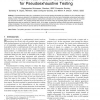Free Online Productivity Tools
i2Speak
i2Symbol
i2OCR
iTex2Img
iWeb2Print
iWeb2Shot
i2Type
iPdf2Split
iPdf2Merge
i2Bopomofo
i2Arabic
i2Style
i2Image
i2PDF
iLatex2Rtf
Sci2ools
ITC
1993
IEEE
1993
IEEE
Novel Test Pattern Generators for Pseudo-Exhaustive Testing
ÐPseudoexhaustive testing of a combinational circuit involves applying all possible input patterns to all its individual output cones. The testing ensures detection of all detectable multiple stuck-at faults in the circuit and all detectable combinational faults within individual cones. Test pattern generators based on coding theory principles are not tailored to a specific circuit as they do not utilize any structural information. They usually generate test sets that are several orders of magnitude larger than the minimum size pseudoexhaustive test set required for a specific circuit. In this paper, we describe hardware efficient test pattern generators that employ knowledge of the circuit output cone structures for generating minimal test sets. Using our techniques, we have designed generators that generate minimum size test sets for the ISCAS benchmark circuits.
| Added | 08 Aug 2010 |
| Updated | 08 Aug 2010 |
| Type | Conference |
| Year | 1993 |
| Where | ITC |
| Authors | Rajagopalan Srinivasan, Sandeep K. Gupta, Melvin A. Breuer |
Comments (0)

